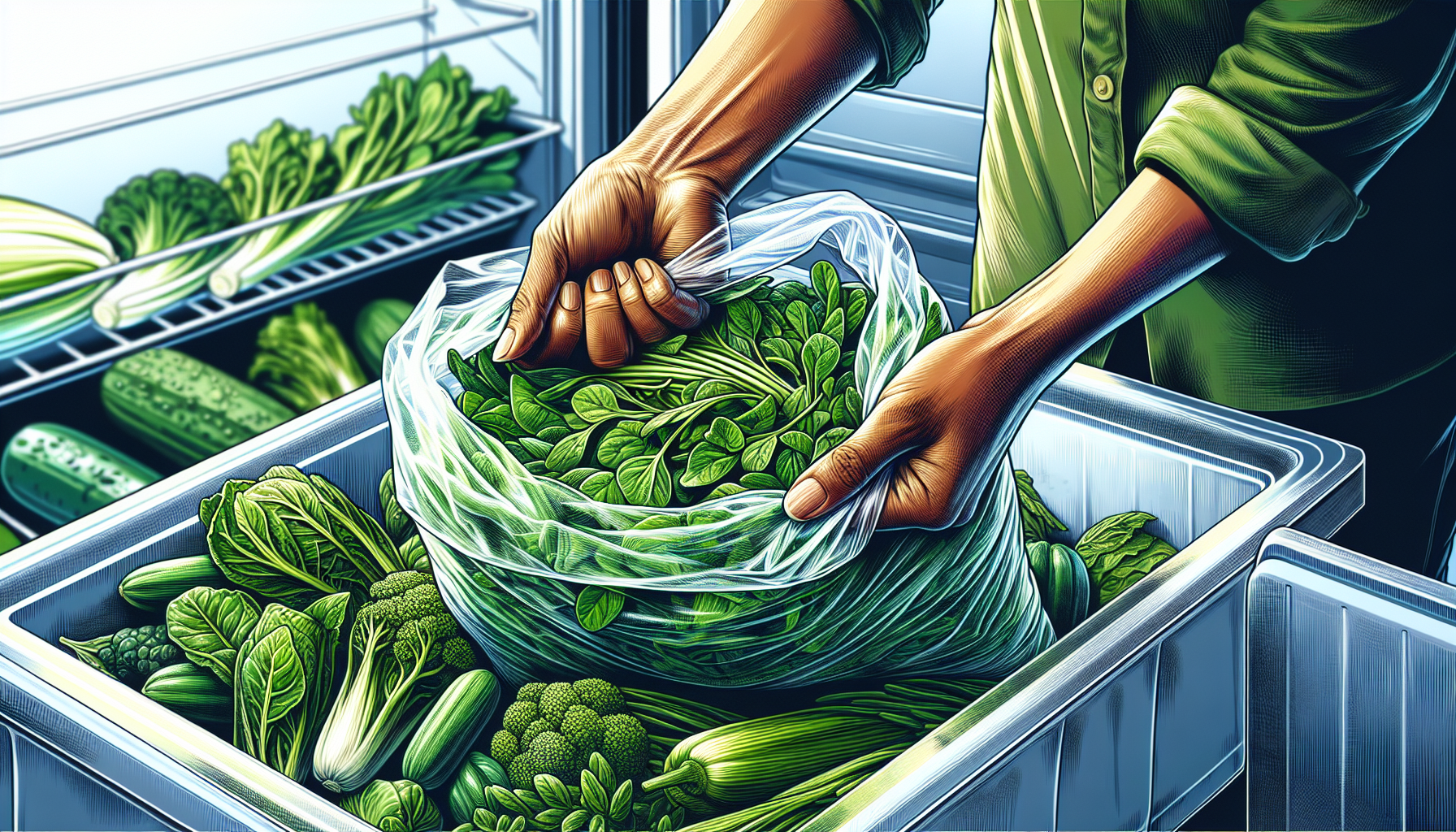Have you ever bought a bunch of fresh greens, only to find them wilted and sad before you have a chance to use them? Don’t worry, because freezing greens is a simple and effective way to preserve their freshness and nutrients. Whether it’s spinach, kale, or collard greens, this article will walk you through the easy steps to freeze greens and keep them readily available for future use. Say goodbye to wasted greens and hello to convenient and nutritious meals with this helpful guide!
Harvesting Greens
When it comes to freezing greens, the first step is to ensure that you harvest them at the right time. For leafy greens like spinach, kale, and Swiss chard, it’s best to pick them when they are young and tender. This will ensure that they freeze well and retain their flavor and texture. Make sure to harvest the greens in the morning, when their moisture content is at its highest. This will help to preserve their freshness.
After harvesting the greens, it’s important to thoroughly wash them to remove any dirt, debris, or pesticides that may be present. Fill a sink or large bowl with cold water and gently agitate the greens to dislodge any dirt. Rinse them thoroughly under running water to ensure that all the impurities are removed. It’s also a good idea to soak the greens in a mixture of cold water and vinegar for a few minutes to kill any bacteria that may be present.
Before freezing the greens, take the time to inspect them and remove any imperfections. Discard any leaves that are wilted, discolored, or damaged. This will ensure that only the best quality greens are used for freezing. It’s also a good idea to remove any thick stems or ribs from the greens, as these can be tough and fibrous.
Blanching Greens
Blanching is a crucial step in the freezing process as it helps to preserve the color, flavor, and texture of the greens. To blanch the greens, start by preparing a large pot of boiling water. Fill the pot about three-fourths full with water and bring it to a rolling boil.
Once the water is boiling, carefully add the greens to the pot. It’s important not to overcrowd the pot, as this can cause the greens to cook unevenly. Allow the greens to blanch for a short period of time, typically around 2-3 minutes for leafy greens and 3-5 minutes for cruciferous greens like kale or collard greens.
After blanching, it’s essential to stop the cooking process by transferring the greens to an ice bath. Fill a large bowl with ice and cold water, and use tongs or a slotted spoon to transfer the blanched greens into the ice bath. This will help to cool them down quickly and preserve their vibrant color.
Freezing Greens
Once the greens have been blanched and cooled, it’s time to prepare them for freezing. Start by draining the greens well to remove any excess moisture. Use a colander or a salad spinner to remove as much water as possible. Excess moisture can lead to icy crystals forming on the greens and can affect their texture and flavor.
To package the greens for freezing, it’s best to use airtight containers or freezer bags. If using bags, ensure that they are specifically designed for freezer use and are able to provide a good seal. Place the drained greens into the containers or bags, leaving some headspace at the top to allow for expansion during freezing.
Labeling and dating the packages is an important step in the freezing process. Use a marker to write the name of the greens and the date of freezing on the containers or bags. This will help you keep track of the contents and ensure that you use the oldest packages first.
Optimal Storage Conditions
To ensure the best quality and taste, it’s important to store the frozen greens in the freezer as soon as possible after packaging. Keep the temperature of your freezer at or below 0°F (-18°C) to maintain the quality of the greens.
When it comes to storing the frozen greens, using airtight containers or freezer bags is crucial. This will help to prevent freezer burn and protect the greens from absorbing any odors or flavors from other foods in the freezer. Make sure the containers or bags are properly sealed to keep the greens fresh.
While it can be tempting to fill up the freezer with as much as possible, it’s important to avoid overcrowding. This can impede airflow and lead to uneven freezing. Leave some space between the packages to allow for air circulation and to prevent the greens from sticking together.
Thawing Frozen Greens
When you’re ready to use the frozen greens, there are a few methods you can use to thaw them. The easiest way is to move the greens from the freezer to the refrigerator and allow them to thaw slowly overnight. This gentle thawing method will help to preserve the quality of the greens and prevent any loss of flavor or texture.
If you need to thaw the greens more quickly, you can use the cold water method. Place the frozen greens in a resealable plastic bag and submerge the bag in cold water. Change the water every 30 minutes to ensure that it stays cold. The greens should thaw in about 1-2 hours using this method.
If you’re in a hurry and need to use the frozen greens immediately, you can add them directly to your cooking. Leafy greens like spinach can be added directly to soups, stews, or sautés without thawing. They will thaw quickly as they cook and will still retain their flavor and nutrition.
Choosing the Right Greens
When it comes to freezing greens, not all varieties are suitable for freezing. Some greens freeze better than others and retain their texture and flavor when thawed. Here are some of the best greens for freezing:
Leafy Greens:
Popular leafy greens like spinach, kale, Swiss chard, and collard greens freeze well and can be used in various dishes. They’re versatile and nutritious, making them a great addition to your freezer.
Cruciferous Greens:
Vegetables like broccoli and Brussels sprouts fall into the cruciferous greens category. These too can be successfully frozen and used later on in stir-fries or roasted dishes.
Herbs:
Certain herbs like parsley freeze surprisingly well. Chop them up, remove any tough stems, and freeze them in small portions. They can be easily added to recipes without the need for thawing.
Tips for Freezing Specific Greens
While the general steps for freezing greens apply to most varieties, here are a few tips specifically tailored to certain greens:
Spinach:
Spinach can be blanched and frozen directly or you can freeze it raw. If freezing raw, simply wash, dry, and portion it into freezer bags or containers. Freezing raw spinach can be handy for adding to smoothies or cooking directly from frozen.
Kale:
Remove the tough stems from kale before blanching and freezing. You can also blanch kale and freeze it in portion-sized bags, making it easy to grab just the right amount for your recipes.
Swiss Chard:
Just like kale, Swiss chard should have its stems removed before blanching and freezing. Chard freezes well and can be used in a variety of dishes like quiches, frittatas, or sautés.
Collard Greens:
Collard greens can be blanched whole or cut into smaller pieces before freezing. Removing the tough ribs is recommended for better texture after freezing. They can be used in traditional Southern dishes like collard greens with ham or simply sautéed as a side dish.
Parsley:
Parsley can be easily chopped and frozen in small portions. Use an ice cube tray to freeze chopped parsley with a little water, olive oil, or broth. Once frozen, transfer the cubes to a freezer bag. This method allows for easy portioning and it’s simple to add frozen parsley cubes directly to your recipes.
Utilizing Frozen Greens
Once you have a freezer stocked with frozen greens, it’s time to start using them in your cooking. Here are a few ideas to help you make the most out of your frozen greens:
Add to Smoothies or Juices:
Frozen greens can be easily added to smoothies or juices for an extra boost of nutrition. They’ll blend right in and provide a burst of freshness and color.
Incorporate in Soups and Stews:
Frozen greens can be thrown directly into soups and stews. As they cook, they will release their moisture and infuse your dish with their flavors.
Make Green Pesto:
Get creative with your frozen greens and whip up a delicious green pesto. Just blend thawed greens with garlic, nuts, cheese, and olive oil for a versatile sauce that can be used on pasta, sandwiches, or as a dip.
Use as a Pizza Topping:
Add a nutritious twist to your homemade pizzas by using frozen greens as a topping. Simply sprinkle the greens over the pizza before baking and enjoy the added taste and texture.
Possible Issues and Troubleshooting
While freezing greens is generally a straightforward process, there are a few issues that can arise. Here are some common problems that you might encounter:
Freezer Burn:
If greens are not properly packaged or stored in the freezer, they can develop freezer burn. This occurs when the moisture from the greens evaporates and the remaining water crystallizes. To avoid freezer burn, make sure to use airtight containers or freezer bags and properly label and date your packages.
Soggy or Watery Greens:
Occasionally, when greens are thawed, they can become soggy or release excess water. This can happen if the greens were not properly drained before freezing or if they were thawed too quickly. To prevent this issue, make sure to drain the greens well before freezing and thaw them slowly in the refrigerator.
Loss of Flavor:
While freezing can help to preserve the texture of greens, some loss of flavor is inevitable. To mitigate this, it’s always best to use the frozen greens in cooked dishes rather than raw. The cooking process can help to enhance the flavor and make it more enjoyable.
Other Methods of Preserving Greens
If freezing greens isn’t the right option for you, there are a few other methods you can try:
Dehydrating Greens:
Dehydrating greens involves removing their moisture content to preserve them. This method can be time-consuming, but it allows you to store the greens for long periods without needing freezer space. Dehydrated greens can be used as crunchy toppings or ground into powders for seasoning.
Canning Greens:
Canning greens involves boiling them and storing them in jars with a sealed lid. This method requires some preparation and equipment, but it can provide a long shelf life for the greens if done correctly. Canned greens can be used in various recipes like casseroles or as a side dish.
Using a Vacuum Sealer:
A vacuum sealer is a great tool for preserving greens. By removing the air from the packaging, it helps to prevent freezer burn and extend the life of the greens. If you plan on freezing a large quantity of greens, investing in a vacuum sealer may be a worthwhile option.
Freezing greens is a convenient way to preserve their freshness and extend their shelf life. By following these steps and tips, you’ll be able to enjoy the taste and nutrients of your favorite greens even when they’re out of season. So go ahead, harvest those greens, blanch them, and stock up your freezer for those delicious and nutritious meals that lie ahead!

